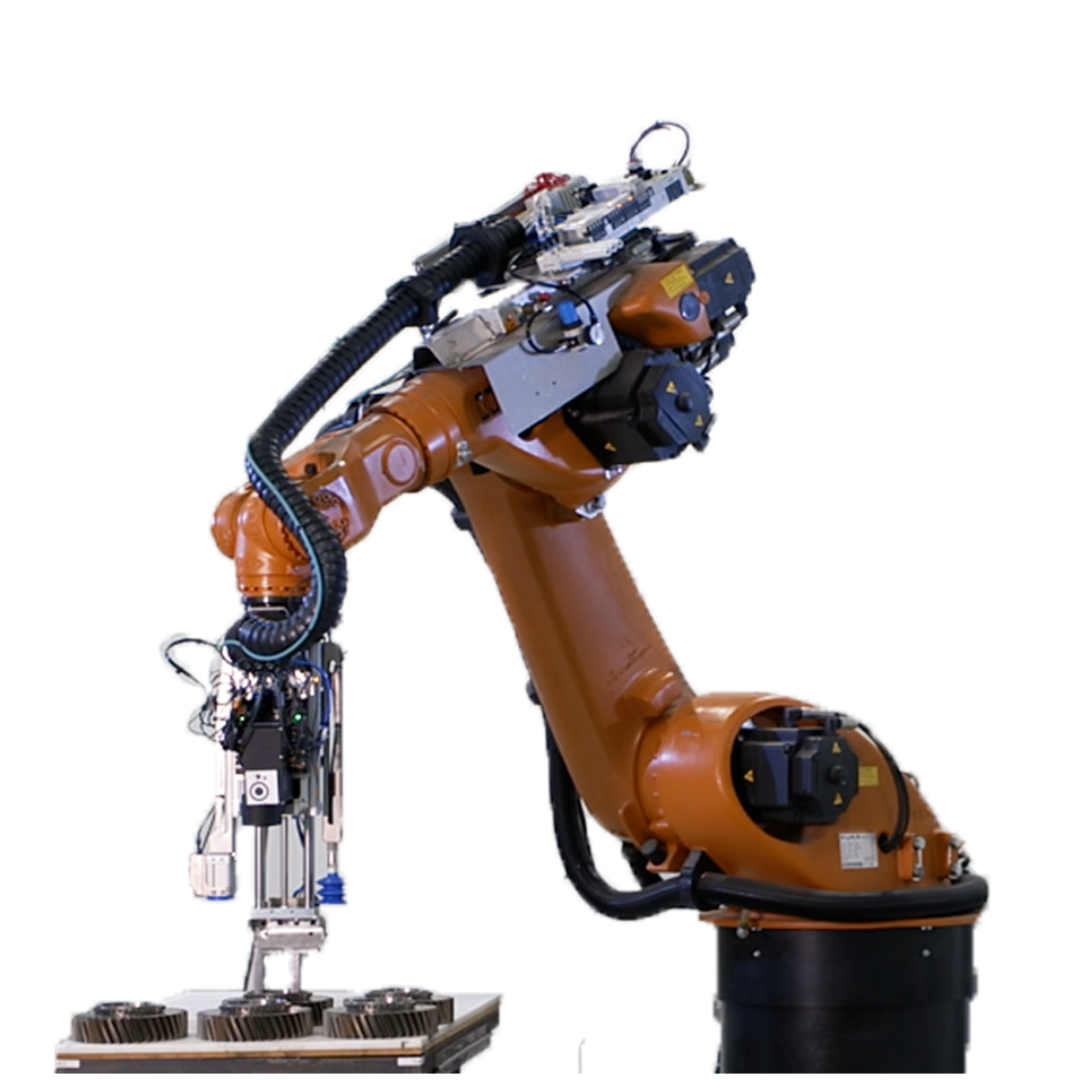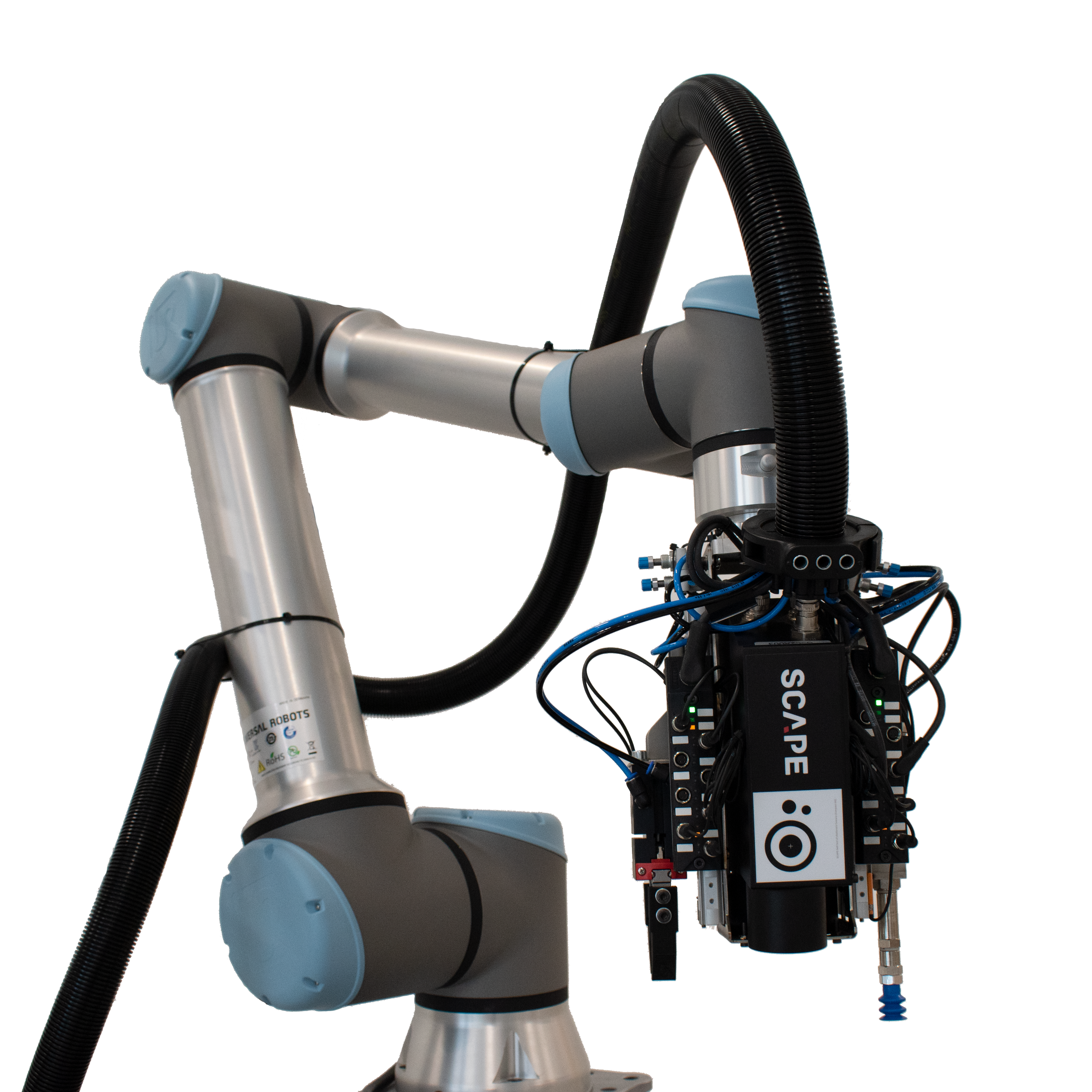WORLD'S FIRST OFF-THE-SHELF BIN-PICKERS
The SCAPE Bin-Picking Solution can be combined with several robots and standard grippers into a powerful solution, which is applicable for all types of parts and used with any 6 axis robot across robot brands. The SCAPE System consists of standardized modules that lets you configure the SCAPE System for exactly your needs.

THE SCAPE BIN-PICKER
This highly flexible and modular solution includes our specialized software packages for picking parts positioned completely randomly, semi-structured parts, or structured parts.
For each SCAPE Bin-Picker variant, you have a number of options such as sensors, grippers, and functionality for configuration of an optimized solution for your needs. All standardized components at a fixed price.
Your SCAPE Partner will help you configure the solution.

THE SCAPE MINI-PICKER
Scape’s well-proven solution is now available for the revolutionizing and intuitive robots.
We have simply built a complete bin-picker platform including specific SCAPE software modules, integrated visions sensors, and gripping tools, which makes up a unique and cost-effective solution for a variety of bin-picking needs for smaller parts.
The SCAPE Mini-Picker is offered for a broader variety of small industry standard robots and collaborative robots.

SCAPE SERVICE OFFERINGS
Scape is offering our customer and partners a number of well-proven and high-quality service packages to optimize your benefits from the SCAPE Bin-Picking Solutions.
Together we make sure to reach your expectations on quality, productivity, and return-on-investment.
DESIGNED TO EXPECT THE UNEXPECTED
The SCAPE Bin-Picking concept enables a wide range of industries to implement a standardized bin-picking solution for a diversity of parts.
Standardized solutions dramatically shorten the implementation time of reliable and effective Bin-Picking systems to automate processes and reduce costs.
This is possible with the advanced SCAPE Bin-Picking Software Suite in combination with a range of recognition and gripping options developed by Scape to ensure a fully reliable and complete solution. The key to a successful bin-picking system is to acknowledge that there is no single configuration which will solve most bin-picking tasks.
Let’s give some examples:
The choice of sensor regarding cycle time
In some cases, a sensor mounted on the robot arm is preferred because it is a cost-effective solution. The drawback is that it adds time to the overall cycle time because the robot needs to move to extra positions in order to acquire data. In many cases, the cycle time is critical and thus a sensor mounted above the bin, i.e. not on the robot arm, is preferred. This can save about 2 seconds in each cycle because the data can be acquired while the robot is delivering a part to its final destination.
The choice of sensor regarding recognition of parts
Each sensor has a limited scan area. However, the sensors supported by SCAPE can handle different view areas ranging from 225x225 mm up to 7950x1500 mm. This means the SCAPE system can handle almost any part size.
The requirements for place orientation
If a part needs to be placed with a specific orientation for every picked part, it can be necessary to perform an extra re-grip after the bin-picking. Say a part is gripped from the bottom but needs to be placed standing with the bottom facing downwards. Then it is necessary to place the part somewhere and re-grip it from another angle.
The requirement for place precision
If a part needs to be placed with high accuracy for every picked part, it can be necessary to perform an extra re-grip after the bin-picking. It is simply impossible to guarantee a precise grip when gripping the part in the bin because of the nature of chaos in randomly placed parts. One example is the fact that a part is sometimes stuck when pulling it away from the other parts in the bin. The result is the part moves a bit in the gripper before it is lifted away from the other parts. The solution is to perform an extra recognition of the part after the bin-picking and then perform a new grip with high precision.
Some examples of other factors to consider when building a bin-picking system are:
Choice of robot
The size of the bins from which to pick the parts and the weight of the parts often defines the size of the robot to be used. In addition, many customers only allow a certain robot brand in their production. This means that the robot control for the bin-picking system must work on different sizes of robots and even different brands.
Various different parts to be picked
It is often a requirement that the bin-picking system can pick several different parts without any changes in the cell. Thus, the system must be able to memorize different parts at the same time and it must have versatile grippers or often multiple grippers.
Different number of bins
In a bin-picking process there are often more than one part that needs to be picked in each cycle. This leads to 2 or more bins placed around the robot and the system must be easy to configure for this dynamic situation. Above were some examples on what is required for a successful bin-picking system. Scape has taken all these factors and more into account when the system was designed. The result is a system consisting of advanced software suite with several different standardized modules which allows it to be configured to almost any imaginable bin-picking process. It is important to note, that it is exactly the same software used in all configurations and there is no programming needed, except the conventional robot programming when moving the robot outside the bins (inside the bin, the SCAPE system controls the robot).
